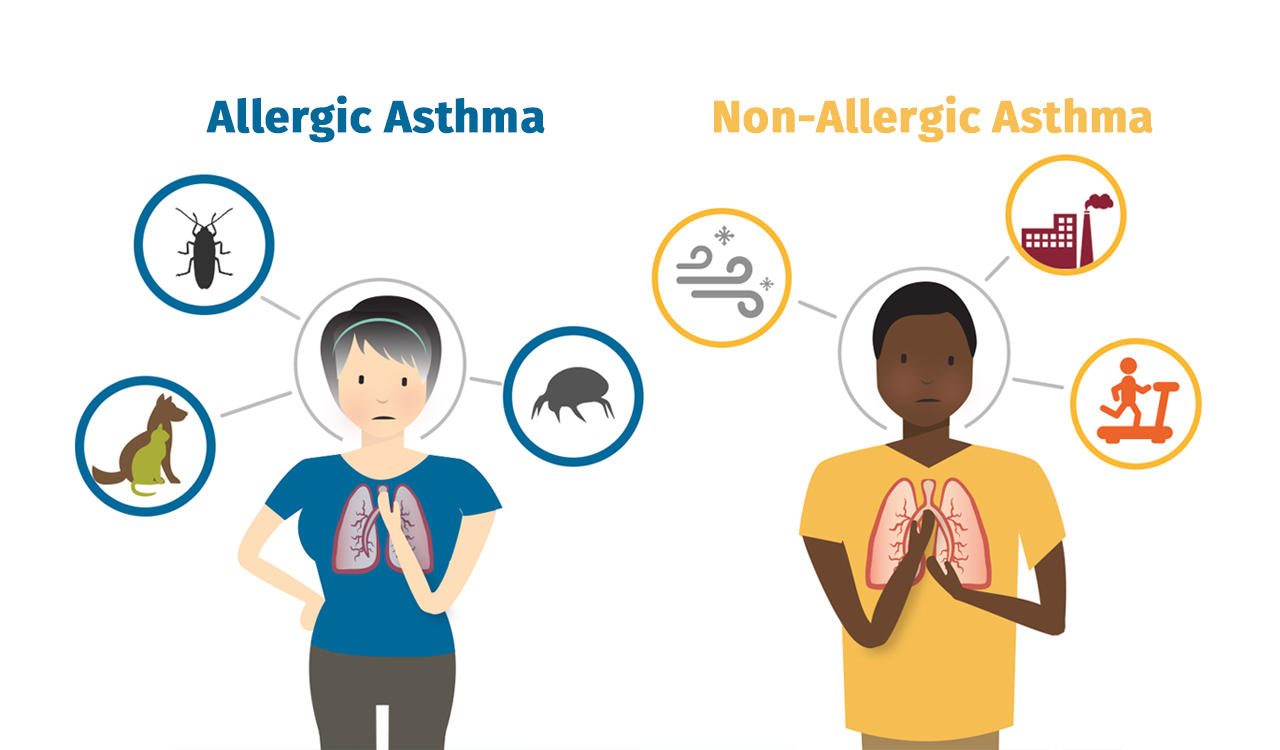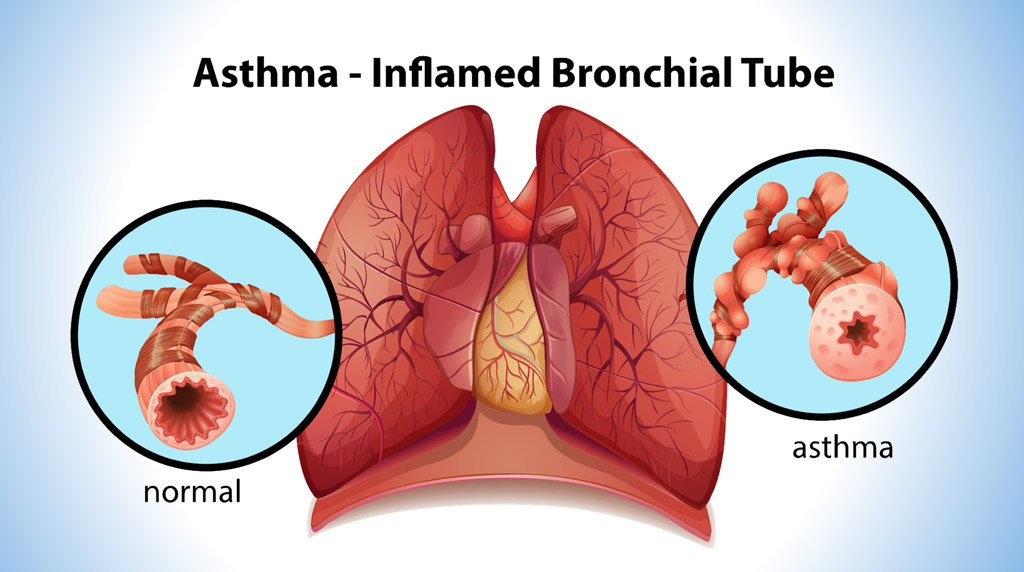Allergic asthma, Asthma, Breathlessness.
Root Cause of Disease
Seasonal asthma is also known as allergic asthma. This condition is caused by allergens and other triggers that occur at specific times of the year. Pollen is one of the most common causes of seasonal asthma.
Symptoms
The symptoms of allergic, seasonal asthma include:
- Difficulty breathing (shortness of breath)
- Coughing
- Wheezing upon exhalation
- Chest tightness or pain
Causes
If you have asthma, you may have noticed that it worsens during certain seasons. For some people, spring, summer, and fall may be particularly challenging times of the year. That’s because seasonal allergens may trigger asthmatic symptoms. When you’re allergic to something, your immune system perceives the allergen as an invader, which must be attacked. In response to the allergen, your immune system produces immunoglobulin E (IgE). IgE is an antibody that triggers the release of histamine when allergens activate it. Histamine causes allergic symptoms such as:
- Runny, itchy nose
- Watery, itchy eyes
- Sneezing
In people with asthma, this process may also impact their lungs and airways, causing asthmatic symptoms. Common triggers of seasonal asthma include:
Pollen
Pollen is produced by trees, grasses, and weeds. Pollen allergies are a common trigger of seasonal asthma. The most prevalent types of pollen depend upon the growth cycle of outdoor greenery where you live. For example:
- spring– tree pollen
- summer– grass pollen
- late summer – ragweed pollen
- fall – ragweed pollen.
Mold and mildew
Other allergens, such as mold and mildew, can also cause seasonal asthmatic symptoms. Mold and mildew are both fungi, which proliferate throughout the year. However, certain molds spread more readily in dry, windy weather. Others are more likely to multiply and spread when it is damp and humid. According to the Asthma and Allergy Foundation of America, allergic reactions to mold are most common during summer and early fall. Mold can proliferate both indoors and outside. Your seasonal exposure to mold may be impacted by weather conditions and lifestyle choices. For example, if you hike in damp, wooded areas during summer of fall, mold may be lurking in and under weeds and logs. You may also be driven indoors during cold winter weather, exposing you to mold and fungi in the home.
Cold weather
Cold, blustery weather outside may impact your activities, leaving you more vulnerable to seasonal asthma. In the winter, you may remain indoors with the windows closed. This can increase your exposure to indoor allergens, such as:
- Dust mites
- Cockroaches
- Pet dander
- Mold
Spending time outside may also trigger asthma. Breathing in cold, dry air can dry out and irritate your airways, causing asthmatic symptoms. Cold air can also increase production of histamine, the culprit behind allergic attacks. Exercising or walking briskly in cold air may worsen these effects.
Hot weather
Summer weather may be hot and dry, or hot and humid. Both types of heat can bring on seasonal asthma. Breathing in hot, dry air can cause your airways to narrow, causing asthmatic symptoms. Humid air is saturated with water. This type of air may also cause your airways to narrow and tighten. People with asthma often find it harder to breathe in humid conditions. Heat of all kinds can increase pollution, by trapping ozone and particulate matter. Stagnant, hazy air can also trigger asthmatic symptoms.
Home Remedies to treat Seasonal Asthma
Remedy- 1: Diet for asthma

While there is no evidence that a specific diet or group of foods prevents or treats asthma, improving your overall health through a healthy diet can have a positive effect. Asthma is a chronic inflammatory disease, which means that your immune system overreacts to non-harmful substances like pollen in your airways. While an inflammatory reaction can help protect you when a dangerous particle enters your body, it can also cause symptoms like swelling in your airways that can restrict your breathing. For this reason, it may help asthma symptoms to eat foods that fight inflammation. “I would recommend a whole food diet that is high in antioxidants, live cultures, and omega-3 fatty acids,”. This type of diet should include
- Leafy greens like spinach and kale
- Berries like cherries and raspberries
- Whole grains like oats and brown rice
- Fatty fish like salmon and tuna
- Nuts and beans.
- Yogurt, sauerkraut, and other fermented foods
- Caffeine is found in coffee, tea, cola drinks and cocoa. Caffeine is a drug that is very similar to theophylline. Theophylline is a bronchodilator drug that is taken to open up the airways in the lungs and therefore relieve the symptoms of asthma, such as wheezing, coughing and breathlessness. Scientists are interested in finding out whether caffeine has the same effect on the lungs as theophylline.
Product link: Caffeine, Yogurt, Raspberries
Remedy- 2: Yoga

Procedure: Yoga
- Sit in a chair. Relax your neck and shoulders.
- Inhale slowly through your nose to the count of two. Keep your lips puckered, as if you’re about to blow out a candle.
- Exhale slowly through your lips to the count .
- Repeat until your breathing returns to normal.
Diaphragmatic breathing
If you have asthma, your body must work extra hard to breathe. It reduces this effort by opening the airways, strengthening your abdominal muscles, and increasing your lung and heart function. This exercise may help soothe your asthma symptoms.
- Sit in a chair or lie down in bed. Place one hand on your belly so you can feel it moving in and out.
- Inhale slowly through your nose. You should feel your stomach move out, filling with air like a balloon.
- Exhale through pursed lips, two or three times longer than your inhale. Your stomach should move in as the air flows out.
- During this exercise, your chest should stay still. You can place your other hand on your chest to make sure it doesn’t move.
Remedy- 3: Turmeric
Materials: Turmeric

Fermented turmeric preparations, commonly sold as tea products, claim to have higher concentrations of biologically available, or absorbable, curcumin.
Procedure:
- Bring water or milk to a boil.
- Add the other ingredients to the boiling liquid.
- Steep for 10–15 minutes.
Product link: Turmeric
Other Remedies
Pomegranate peel Extract
Pomegranate peel extract is a natural substance sold in dietary supplement form. It is sourced from the peel of the pomegranate fruit. Pomegranate fruit is often touted as a top source of antioxidants including vitamin C. The use of dietary supplements containing pomegranate peel extract is said to provide a large range of health benefits including the treatment of asthma. Pomegranate peel extract contains ellagitannins, which are compounds known to reduce inflammation. This is a very crucial property and serves significantly in asthma treatment.
Green Tea
Green tea is considered by many to be nature’s healthiest beverage and is very rich in antioxidants that would help in asthma treatment. Green Tea is lower in caffeine than other caffeinated beverages and contains the amino acid L-theanine shown to induce relaxation and relieve stress which is one of the major emotional causes of asthma.
Hibiscus
Hibiscus is a plant said to offer several health benefits. Scientific research suggests that hibiscus tea or hibiscus extracts may offer antioxidant effects and this is significant in the elimination of allergens in asthma treatment.
Preventions
In addition to using maintenance medications, you can take steps each day to help make yourself healthier and reduce your risk for asthma attacks. These include:
Eating a healthier diet. Eating a healthy, balanced diet can help improve your overall health.
Maintaining a moderate weight. Asthma tends to be worse in people with overweight and obesity. Losing weight is healthy for your heart, your joints, and your lungs.
Quitting smoking if you smoke. Irritants such as cigarette smoke can trigger asthma and increase your risk for COPD.
Exercising regularly. Activity can trigger an asthma attack, but regular exercise may help reduce the risk of breathing problems.
Managing stress. Stress can be a trigger for asthma symptoms. Stress can also make stopping an asthma attack more difficult.
Nutrient-rich foods are vital to helping reduce symptoms, but food allergies can trigger asthma symptoms.




